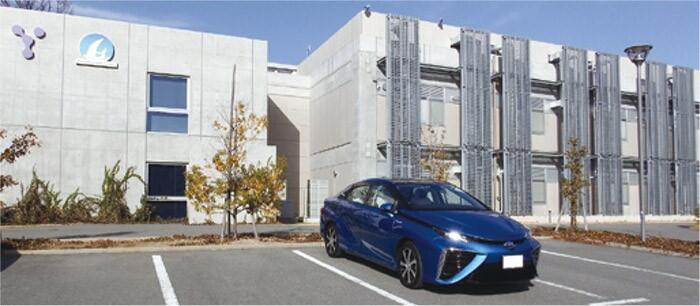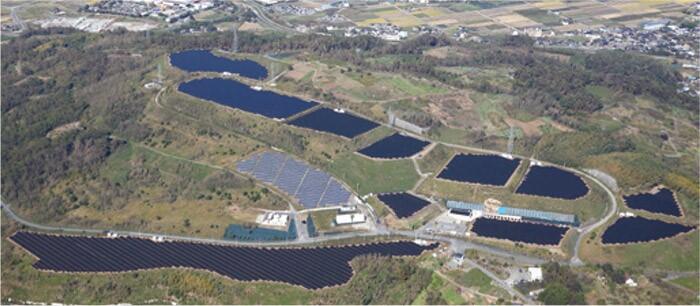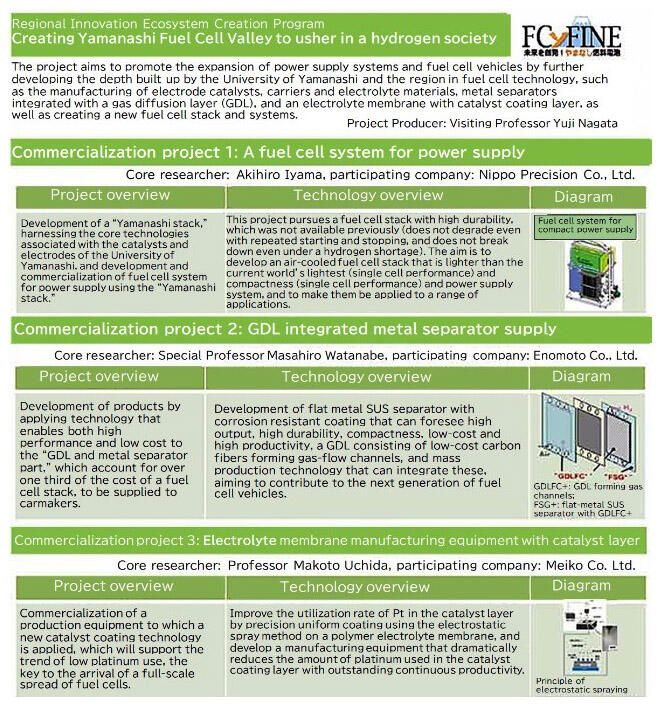Prime Minister Yoshihide Suga pledged in a policy speech on October 26, 2020 that Japan would aim for the realization of a carbon-neutral society by 2050. The field of energy is a particular focus of decarbonization efforts, and among other energy sources, high expectations are placed on hydrogen, which is also called the "trump card" of decarbonization. Hydrogen is well known by people as it is taught in science classes at junior high school, but its use as energy is less widely known. Although today we hear more about it in the context of decarbonization, here in Yamanashi Prefecture, the University of Yamanashi has been conducting research and development on the use of hydrogen as an energy source in fuel cells for over 40 years.
Concentration of hydrogen and fuel cell-related research labs
What sets Yamanashi Prefecture's hydrogen and fuel cell project apart from other similar projects is that it has a cluster of research centers including the University of Yamanashi, covering the full cycle from hydrogen production to use. This cluster of R&D laboratories is expanding and includes the University of Yamanashi's Clean Energy Research Center, a world-class research center that has been undertaking fuel cell research for national projects, the Fuel Cell Nanomaterials Center, the Fuel Cell Evaluation/Testing Facility at the Yamanashi Industrial Technology Center, the Hydrogen Technical Center of the Association of Hydrogen Supply and Utilization Technology (HySUT) and others. Moreover, the Fuel Cell Cutting-Edge Research Center Technology Research Association (FC-Cubic) is set to relocate to Yamanashi during FY2022. These laboratories and facilities serve as a base that greatly contributes to technological development that should be the basis of business development in companies, such as generating technological seeds that lead to performance improvement and cost reduction, which is the key to commercialization of hydrogen and fuel cells, as well as evaluation and demonstration of materials and products. The New Energy and Industrial Technology Development Organization (NEDO) has commissioned the Yamanashi Prefecture Enterprise Bureau to conduct empirical research on a Power-to-Gas (P2G) storage and utilization system at the Komekurayama Electric Power Storage Technology Research Site in Kofu City, Yamanashi, where hydrogen is produced using solar power. This system, that takes advantage of hydrogen's long term storage and transportation characteristics, is expected to be one of the technologies that contributes to the stabilization of renewable energy generation, which is subject to fluctuation depending on changes in weather conditions. The hydrogen generated at Komekurayama will soon be used for electricity and heat in factories and commercial buildings within Yamanashi Prefecture. In this way, the project for the complete energy cycle from hydrogen production to use is conducted in Yamanashi Prefecture.


Collaboration between industry, academia, and government
In 2015, the University of Yamanashi, the Yamanashi Industry Support Organization and relevant departments of the Yamanashi Prefectural Government established the Yamanashi Hydrogen & Fuel Cell Network Association to proceed with the accumulation and fostering of a hydrogen and fuel cell industry as an industry-academic-government collaboration. The association plays a central role in promoting the entry of companies in the prefecture into local industry by providing technology transfer to promote the development and commercialization of hydrogen and fuel cell-related products utilizing technology seeds from the University of Yamanashi, offering technological support and human resources development utilizing accumulated know-how, and building the network with hydrogen and fuel cell-related manufacturers.

The potential of the industry in Yamanashi
For a company to enter the hydrogen and fuel cell sector, advanced technology to control the supply of hydrogen and air to fuel cells and advanced production technology, including a variety of practical expertise, are required. Fuel cell systems use electronic parts, devices, and electronic circuitry parts, which are key products of Yamanashi's manufacturing industry. The prefecture is also home to many companies with precision micromachining technology that is needed to manufacture metal and resin parts. These are the technological abilities that enable a company to enter the hydrogen and fuel cell sector, and there are companies that have already done so. There are also companies that have begun to work on joining the sector through the industry-academia-government collaboration involving the University of Yamanashi and the prefectural government.
The FCyFINE project
The University of Yamanashi and Yamanashi Prefecture have been selected for the Regional Innovation Ecosystem Creation Program (*1) by the Ministry of Education, Culture, Sports, Science and Technology to develop hydrogen and fuel cell products jointly with companies in Yamanashi. This project is called the FCyFINE (*2), which aims to further develop the strength of the fuel cell technology that the University of Yamanashi has been cultivating over many years, create new types of fuel cells and systems, and expand those to applications into areas such as power supply systems and fuel cell vehicles. The team is mainly working on three major commercialization projects: (1) a fuel cell system for power supply, (2) a gas diffusion layer (GDL) integrated metal separator supply, and (3) an electrolyte membrane manufacturing equipment with catalyst layer. In regards to these projects, the team is conducting joint development with companies headquartered in Yamanashi, aiming for future commercialization This is an effort that combines the strengths of the local university and the development technologies and daring spirit of local businesses.

As the research cluster has grown in Yamanashi, experts are also being drawn to the prefecture. In collaboration with the University of Yamanashi, the Hydrogen Fuel Cell Industry Technical Training Course was launched to leverage the knowledge and skills held by this precious talent pool in the area of hydrogen fuel cell products to train the human resources that support and sustain Yamanashi's hydrogen fuel cell-related industries. Professors from the University of Yamanashi are joined by instructors who are engineers working at the frontline of major companies in the hydrogen/fuel cell industry. FY2020 was the fifth year of the course, with the 99 past participants now pursuing their careers at companies in Yamanashi, and many companies have come back for more. In addition to forming ties among participants of the course and exchange among companies, there are major benefits for those firms hoping to move into the hydrogen fuel cell sector in building relationships with Japan's top-level instructors. The prefectural government has also established hydrogen fuel cell specialists as " hydrogen and fuel cell sector support producers" (*3), in order to assist companies with technology development and business matching. The producers are dispatched free of charge to companies in Yamanashi to assist with their individual needs.
With these initiatives providing meticulous support measures in collaboration with universities and specialist professionals, Yamanashi Prefecture is offering a highly conducive environment for companies to join the sector.
Establishing the Yamanashi HFC cluster
The "Yamanashi HFC (hydrogen and fuel cell) cluster" was established in FY2020 as a hydrogen and fuel cells-related industry association. It joins the technological capability of Yamanashi companies and promotes their industrial development in Japan and overseas. In addition to Yamanashi companies, the cluster includes the University of Yamanashi, the Yamanashi Industry Support Organization and hydrogen and fuel cell sector support producers. It provides updates about hydrogen and fuel cells from experts in Yamanashi, holds information-sharing sessions in which participants can freely exchange opinions, runs technology workshops to foster matching by allowing Yamanashi businesses to propose their technologies to large corporates, and conducts business matching with overseas industrial clusters in conjunction with JETRO Yamanashi.
Metal product manufacturers make up the bulk of registered companies of the Yamanashi HFC cluster, but members do not just include those dealing with fuel cell parts themselves. A wide range of players are engaged including companies that make equipment in which fuel cells are installed, companies that use the equipment, and companies involved in hydrogen production and systems development. In FY2021, under the supervision of the hydrogen and fuel cell sector support producers, a consortium within the Yamanashi HFC cluster was set up to undertake new endeavors in cooperation with registered companies.
The Yamanashi HFC cluster also holds seminars on hydrogen and fuel cells. Providing opportunities to its members to listen to lectures by engineers from major companies about their companies' initiatives and explanations of their products, and by watching seminars by association staff active in industrial clusters in Japan, the intention is to boost the momentum of the activities of the Yamanashi HFC cluster. In the future, we hope to start similar interactions among industry clusters, leading to business matching between different regions.
"Make Yamanashi a testbed sanctuary harnessing local characteristics"
The "Linear Yamanashi Vision" (*4), a plan formulated in March 2020, set up the idea of making the prefecture a "testbed sanctuary harnessing local characteristics" as a measure. Hydrogen and fuel cell technology R&D in Yamanashi is actively conducted under the framework of industry-academia-government collaboration, and the prefecture has prioritized and is working to invite the testbed for realizing a decarbonized society, with hydrogen and fuel cell-related technologies built up over years of research and technology seeds at the core.
The hydrogen/fuel cell sector is currently led by the West, but looking at our Asian counterparts, China is investing vast sums in the sector as it runs in hot pursuit. Domestically, the Ministry of Economy, Trade and Industry formulated the "Green Growth Strategy Through Achieving Carbon Neutrality in 2050" in December 2020, setting out a growth strategy process for fuel cells up to 2050. While the development of a hydrogen and fuel cell industry does necessitate a long-term perspective, if we have not moved already, then we would be left behind by our foreign competitors. In Yamanashi, we have the hydrogen and fuel cell R&D history, technology, and expertise, linked in a network of industry, academia and government that builds on our mutual strengths to proceed with the initiatives. We are now developing a system, which will enable us to collaborate not just within Yamanashi but also both domestically and globally.
In conclusion, I hope that any company and research institutions outside of Yamanashi Prefecture become interested in our initiatives.
- A program to realize a Japanese model of innovation ecosystem and regional revitalization, based around core technologies of local universities to incorporate local and non-local human resource and technologies, formulate commercialization plans that enable global expansion, and promote commercialization projects that contribute to the regional growth and the growth of national wealth.
- Abbreviation for Fuel Cells-Yamanashi Frontier for Innovation and Ecosystem
- Two producers have been appointed: Hidemi Oonaka, former chief of the Fuel Cell Development Division and other senior positions at Toyota Motor Corporation and current FC-Cubic TRA Executive Director and Hiroshi Nakamura, Research Fellow at the Japan Industrial Location Center, formerly Awareness Promotion Working Group Leader for the Japan Hydrogen & Fuel Cell Demonstration Project at Honda Motor Co., Ltd., and a special advisor at the Hydrogen Energy Test and Research Center (HyTRec).
- A section plan of the Yamanashi Comprehensive Plan to surely attract prosperity to Yamanashi leveraging the opening of the Linear Chuo Shinkansen line for the direct benefit to enrich the life of all residents.
Isao Yamadera, Growth Industry Promotion Section, Industry and Labor Department, Yamanashi Prefecture




